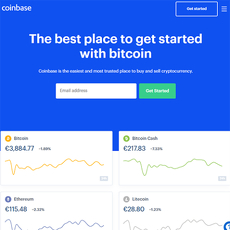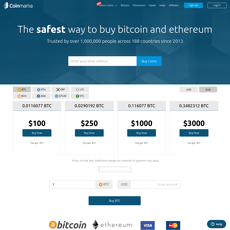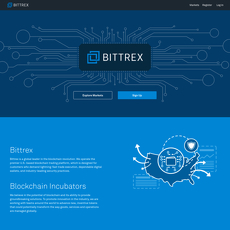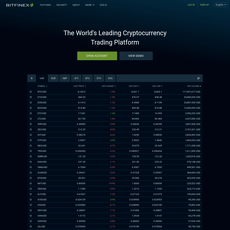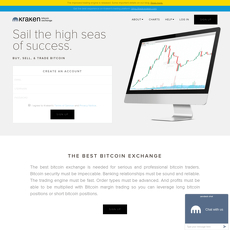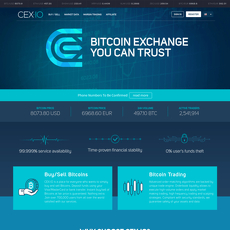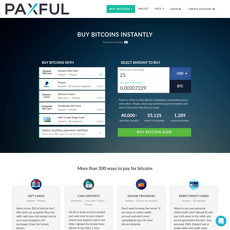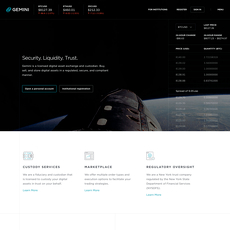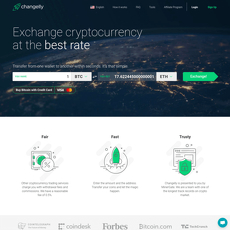bitpanda Review
bitpanda
www.bitpanda.com
Bitpanda Review Guide: Everything You Need to Know About Bitpanda With FAQ
Ever sat there, scrolling through endless crypto platforms, thinking, “Why can’t this just be easy?” You’re not alone. The struggle to find a crypto exchange that’s actually user-friendly, secure, and doesn’t drain your wallet with hidden fees is real. If you’re curious about Bitpanda, or wondering if it actually does what it claims, you’re right where you need to be.
I get questions every week about where beginners (and even crypto veterans) should buy, sell, or swap coins—especially when it’s time to change Bitcoin or your favorite altcoin into cash. It’s confusing, right? You always hear about risks and crazy fee structures that are harder to understand than blockchain itself!
Suddenly, Bitpanda pops up everywhere. So what’s the hype? Why do so many people mention it when talking about hassle-free trading or headaches with other exchanges?
What’s Wrong with Most Crypto Exchanges?
Let’s be honest—a lot are downright frustrating. Here’s what most new users (and even those who’ve traded for years) complain about:
- Security worries: Who wants to wake up to a compromised account?
- Wild fee surprises: Gotcha fees that eat into your profits, sometimes totally hidden until it’s too late.
- Impossible verification: Weeks waiting for approval, only to be asked for even more documentation or, worse, getting rejected for no reason.
- Cluttered, confusing platforms: Some sites look like they were designed for rocket scientists, not real people wanting to buy or sell crypto.
It’s not just “complainers” saying this, either. According to a Binance user survey, 40% of respondents said they were nervous about insufficient security. And a recent study from Statista showed that high, non-transparent fees are one of the main reasons people leave exchanges altogether.
How Bitpanda Claims to Solve These Issues
Bitpanda isn’t just promising another fancy dashboard. Here’s what they claim will actually make your life easier:
- Speed: Fast account setup and transaction processing, with clean, modern design.
- Ease of use: A beginner can sign up, verify, and buy their first crypto in minutes (not days).
- Security: Built-in 2FA, strong encryption, plus a solid reputation for keeping user funds safe.
- Multi-asset support: Not just crypto—Bitpanda offers trading in precious metals like gold and silver, too. That actually sets it apart from most other “crypto only” exchanges.
But can Bitpanda back up these claims? Is it really as convenient (and safe) as people say, or is it just another flashy exchange in a crowded market?
What You’ll Get From This Guide
This isn’t just another rehashed exchange review. You’re going to see:
- How Bitpanda compares head-to-head with major competitors
- Real-pros and cons—not just the shiny marketing stuff
- Actual user stories (yes, the good, the bad, and the truly weird)
- Frequently asked questions answered straight-up
- My best tips for picking a safe, user-friendly exchange that works for you
Ready to see what Bitpanda actually is, why some people swear by it (and others avoid it), and how it could fit into your crypto journey? Stick with me—let’s take a look at where Bitpanda fits, who it’s made for, and why it might (or might not) be your next crypto home. Curious about what Bitpanda really is and what you can do with it? The next section has the answers you’ve been looking for…
What is Bitpanda?
A quick intro to Bitpanda
What if getting started with crypto felt as easy as online shopping? Bitpanda, built in Vienna, Austria, does exactly that—a digital investing hub where you can buy and sell Bitcoin, Ethereum, and a solid handful of altcoins. But here’s the kicker: you can also trade precious metals like gold and silver, all in the same place. Imagine checking your crypto, gold, and even fractional ETFs all in one app… That’s not just handy for new investors—it's actually a small superpower for anyone who likes keeping things simple and under one digital roof.
Bitpanda’s sweet spot? Simple design, fast fiat onramps (think: SEPA, credit card, Skrill, and more for EUR and a few other currencies), automated savings, and rock-solid security. Whether you’re in Germany setting up your first recurring Bitcoin buy, or in France looking to cash out dogecoin for euros—Bitpanda is engineered to make the process friendly, not frustrating.
Why people choose or avoid Bitpanda
Let’s cut through the noise. Some folks rave about Bitpanda’s:
- All-in-one investing: From crypto to precious metals, even stocks and ETFs (if you’re in the right country—it pays to check the fine print!)
- User interface: Beginner-friendly, straightforward—no complicated charts in your face unless you want them
- Fast euro onramps: Great for Europeans—bank transfers are super quick, and you can deposit or withdraw without a headache
- Solid reputation: Regulated by Austrian financial authorities, which gives a lot of users peace of mind
But it’s not for everyone:
- Live outside Europe? Some features (like full fiat functionality or stocks) are regional. You might hit a wall if you’re not in the EU or certain supported countries.
- Looking for the lowest trading fees? Hardcore traders sometimes skip Bitpanda in favor of advanced platforms with tighter spreads or lower commissions.
- Want complete privacy? Bitpanda’s strong compliance (KYC/AML) might feel strict if you’re privacy-obsessed.
“The platform is the most straightforward I’ve used for buying Bitcoin with euros. No overwhelm, no drama. That’s why I stick around.” — a Bitpanda user review on Trustpilot
If you just want to get in, convert, and get out—minus the anxiety of losing funds or fumbling through jargon—Bitpanda is a magnet for you. On the flip side, power users who crave deep analytics or margin trading might find it a bit lightweight.
Where Bitpanda fits among top exchanges
You know what’s wild? Most new users on Cryptolinks want exchanges that feel safe and familiar, without sacrificing the core crypto freedom. That’s exactly why Bitpanda lands on so many “top 10” lists for Europe—especially for BTC-to-fiat swaps (and back again). A 2023 industry report even highlighted how euro-based exchanges saw a 36% jump in retail sign-ups. Platforms like Bitpanda literally help keep the bridge open between the crypto universe and our good old banking system.
And let’s be real: if your goal is to move seamlessly between your favorite coins and your real-world wallet with minimal hassle, you want the right tool for the job. Bitpanda is one of the names I constantly see trusted by both rookie buyers and those who’ve been stacking sats since 2015.
Curious about how the magic actually works under the hood? Wondering which assets you can trade, how their KYC really feels, or if it’s actually as quick as everyone claims? Hold on tight—it’s about to get interesting in the next section, where I break down the steps and secrets to getting started, swapping, and navigating Bitpanda like a pro.
How Bitpanda Works
Account creation and verification
Ready to jump in? Signing up with Bitpanda honestly feels like setting up any modern fintech app. I’ve personally walked through it dozens of times, and here’s what you can expect:
- Create your account: Email, strong password, confirm via email link. Standard stuff—not much different from your Netflix or Instagram sign-up.
- Verification (KYC & AML): Here’s where things get real. To comply with regulations (and keep users safe from fraud), Bitpanda needs you to verify your identity. Grab an accepted ID (passport, driver’s license), and be ready to snap a selfie or do a live video. The app walks you through it, but sometimes your phone camera quality can cause hiccups—so be patient if you have to try more than once. Average verification times: minutes to a couple hours.
- Why all this? If you’re thinking, “Why so much hassle?”—it’s not just about box-ticking. According to a 2023 Chainalysis report, strict KYC policies drastically reduce illegal activity. For legit users, that’s a win.
“The safest investment platform is one that actually knows who its users are.” – Security analyst at CipherTrace
Buying, selling, and swapping crypto
So, you’re verified—what next? Buying Bitcoin (or any supported coin) on Bitpanda is smoother than you might expect. Here’s the process as I experienced it:
- Fiat deposit: Top up your account with EUR, USD, GBP, CHF—the essentials. You’ve got a solid choice between SEPA transfers, credit/debit cards, Skrill, Neteller, and sometimes even local payment options (depending on your country). If you’re in Europe, SEPA is fast and cheap.
- Buy/sell/swap: Pick your coin, enter the amount, check the live rate, confirm—all done in seconds. Bitpanda lets you swap crypto-to-crypto instantly too. For example, want to swap some Bitcoin for Ethereum? It’s just a couple of taps.
- Withdraw: Sold some crypto or metals and want the cash back in your bank? You can withdraw to your deposited method or bank, sometimes in as little as a few hours. I’ve personally seen EUR show up within 45 minutes using SEPA.
Multiple studies (Statista, 2024) show that simple, reliable fiat gateways are among the top three reasons people stick to an exchange—Bitpanda nails this.
Supported currencies and assets
Bitpanda is not just about Bitcoin and Ethereum—though those are always popular. The platform supports over 100 cryptocurrencies, including:
- BTC, ETH, XRP, ADA, DOT, LTC, DOGE, SOL, MATIC (and plenty more)
- Fiat: EUR, USD, GBP, CHF
- Precious metals: Buy and trade gold, silver, palladium, and platinum—fractional, fully backed by vault storage in Switzerland.
Not every platform gives you the chance to hedge your crypto with metals. For some, that’s a game-changer when markets get shaky.
Mobile and web experience
This part always gets the most feedback in my inbox. “Is the Bitpanda app actually good?” The short answer: Yes. The app (iOS & Android) and web platform are both clean, lightning-fast, and don’t overwhelm you with charts or jargon if you’re new. But there’s enough advanced info for pros—depth charts, instant price updates, and real-time portfolio tracking.
- User-friendly interface: Both desktop and mobile layouts make even advanced trading tools feel approachable.
- Mobile-first features: Instant push notifications for buys, deposits, and price alerts. You can enable biometric login for extra safety.
- Seamless syncing: Start a transaction on the web, finish it on your phone, no headaches.
And if you love checking prices on the go, the widgets and recurring buy features on the app are some of the best I’ve used.
Still, if you’re wondering how Bitpanda’s model compares to other types of exchanges, or what makes their centralized setup different, I’m about to pull back the curtain in the next section—because not every exchange plays by the same rules, and the differences might surprise you…
Types of Crypto-to-Fiat Exchanges (And Where Bitpanda Sits)
Centralized vs. Decentralized Platforms
There’s a big split in the crypto world: some folks swear by classic centralized exchanges, others won’t settle for anything less than full peer-to-peer or decentralized control. So where does Bitpanda fit? Let’s break it down.
- Centralized exchanges (CEX)—like Bitpanda, Coinbase, or Kraken—are basically the “banks” of the crypto world. You set up your account, deposit money (fiat or crypto), and they handle your funds and trades.
- Decentralized exchanges (DEX)—think Uniswap or PancakeSwap—don’t hold your money at all. You use your wallet directly, never handing over control of your coins.
- P2P platforms—like LocalBitcoins or Paxful—connect buyers and sellers directly. No middleman holding funds, just smart contracts or escrow.
Imagine it this way: centralized platforms like Bitpanda are like the easy button—fast, smooth, user-friendly—but you’re trusting them with both your money and your data. Some call it “trading convenience for security.” Others, especially newbies, call it “finally making crypto easy.”
“Convenience is not always free—sometimes it costs you transparency or even some control. The key is knowing what matters most to you.”
How Bitpanda’s Model Helps Users
Bitpanda is proudly centralized. Why does this matter? Well, it means you can:
- Sign up in minutes—no wrestling with 17 browser extensions or odd wallet apps
- Buy or sell instantly—the orderbook is deep, and Bitpanda manages liquidity behind the scenes
- Get customer support—if you make a mistake, there’s an actual human to help you
- Enjoy peace of mind (for many)—your crypto isn’t riding wild inside weird smart contracts or bouncing around in multi-step swaps
But of course, the flip side is that you’re trusting a company (even one with a strong European license) with your funds—rather than only yourself and the blockchain.
There’s a reason studies show that beginner crypto users in Europe often pick brokers like Bitpanda first. According to a Cointelegraph report on European crypto adoption, people gravitate toward trusted, regulated, centralized platforms to get their feet wet. Once they build confidence, some might eventually branch out to DeFi or peer-to-peer.
For most people who just want to buy some Bitcoin with EUR, swap it for ETH, or cash out to the bank, Bitpanda’s centralized model is actually what makes it feel “normal” and safe.
Alternatives to Bitpanda (And Why You Might Care)
Every crypto journey is personal. Maybe you want absolute control over your coins. Or maybe you need to swap unusual tokens that Bitpanda doesn’t offer. Here’s where other models shine:
- P2P (peer-to-peer) exchanges—such as LocalBitcoins—let you negotiate directly with other people. There’s no “bank,” just a digital handshake.
- DEXs—like Uniswap—allow you to swap tokens straight from your wallet, no account required.
Of course, these options take away hand-holding, but you gain privacy, freedom, and sometimes access to more obscure tokens.
Not sure which model actually fits your goals? I’ve got a full comparison of alternatives (and when to use them) over at Cryptolinks if you want to see which exchange could work best for you.
But here’s the big question: now that you know the type of exchange Bitpanda is, how do they stack up when it comes to protecting your assets and pocket? What about those fees and customer support stories you keep hearing? Stick around—the next part is where things usually make or break an exchange for everyday users.
Features That Matter: Security, Fees, and Support
Security measures at Bitpanda
Let’s face it: nobody wants to wake up to a missing balance. The threat of getting your crypto hacked is real. Bitpanda knows this, and they don’t take shortcuts. If you’ve ever lost sleep over security (who hasn’t?), you’ll appreciate what they’ve built in.
- Multi-factor authentication (2FA): Even if your password somehow leaks, they’ll still need your phone or device to get in.
- SSL Encryption: All data—yes, every login and transaction—is fully encrypted end-to-end. Even Europe’s heavy-handed GDPR rules are met and exceeded here.
- Offline (cold) storage: Most customer funds are tucked safely offline. In the rare cases where assets are online, real-time monitoring helps spot anything odd instantly.
- Insurance: While not every detail is public, Bitpanda claims insurance covers many of their custodial assets. It won’t make you bulletproof, but it’s a serious safety net if something blows up.
- Bug bounty & regular audits: Bitpanda encourages outside experts to find issues, and yes, they actually pay for this. That’s usually the mark of a platform that’s serious about security—not just talking a big game.
“Security is not a product, but a process.” — Bruce Schneier
Remember that time a major exchange lost hundreds of millions overnight? Bitpanda’s never been the headline like that—and that means a lot in this space.
Fee breakdown and transparency
Let’s talk other annoyances: hidden fees. Many platforms will quietly drain your balance over time (think of those sneaky 1-2% fees tacked onto every trade). Is Bitpanda better?
- Trading fees: Bitpanda charges about 1.49% for buying/selling crypto. Not the cheapest, not the priciest—just clear. You see the fee before confirming each trade.
- Deposit fees: Euro SEPA transfers? Free. Credit card? Expect some charges (usually from your card issuer, not Bitpanda). Skrill, Neteller, and other instant options have small fees, all shown upfront.
- Withdrawal fees: Crypto withdrawals are dynamic—set by the network, not Bitpanda. Fiat withdrawals via SEPA are free; others cost a bit (full breakdown’s always on their site).
- No “hidden” extras: Unlike some platforms that sneak in random admin or inactivity fees, Bitpanda is pretty honest. I looked—nothing lurking in the small print.
Always double-check fees before locking in a trade, especially if you’re moving bigger sums. That “small” percent can sting—one user shared on Reddit that their $2000 Bitcoin sale cost over $28 in fees. Imagine if you were flipping coins every week!
Customer support and feedback
Stuck, worried about a transfer, or just unsure? Bitpanda’s customer support isn’t perfect (no exchange is!), but it generally gets good reviews for being:
- Responsive via email ticket: Most users get replies within hours—but sometimes it stretches to a day or two in busy periods.
- Multi-language help: Support in English and German is best, but they cover a bunch of EU languages. Great if English isn’t your thing.
- Solid FAQ center: Straightforward guides make it quick to find most answers yourself; they even explain fund tracking, payment issues, and step-by-step account recovery.
Real feedback from Trustpilot? Bitpanda scores about 4 out of 5—solid for a crypto brand. Folks praise the quick help when banks slow down transfers, but some vent about hiccups when uploading tricky ID documents. If you ever wonder, “Why is my account locked?”—the answer is almost always KYC documentation issues, so keep digital copies handy.
When you’re choosing a platform, these features really separate the heroes from the has-beens. But honestly, even the best features don’t matter if using the site just frustrates you, right? So, how does Bitpanda really feel when you log in and start trading every day? The answer might surprise you, and it's coming up next—ready to see if Bitpanda is actually easy (or secretly a headache)? Keep reading—you’ll want to see this before your first swap!
User Experience: Is Bitpanda Actually Easy to Use?
Sign-up and Onboarding for Beginners
Starting something new is always a bit nerve-wracking, right? The last thing you want is to get lost in a maze of identity checks and confusing steps when all you want is to buy or sell some crypto. On Bitpanda, the entire onboarding feels like it’s made for humans, not robots—or those with patience for 14-step forms.
After testing it myself, here’s how quick it actually feels:
- You pop in an email address, make a password, and you’re already halfway there.
- KYC kicks in after a certain trading limit, but the process is smooth—think uploading a passport and taking a selfie, just like opening a modern bank account.
- Many new users report being verified and ready to trade in under 15 minutes, which is honestly a breath of fresh air compared to exchanges that turn this stage into a marathon.
People want simplicity. This is the bit I hear most: “I was up and running within the same coffee break.” Not many platforms can say that.
Web and Mobile Design
Clean. Fast. No-nonsense. These are the three words that come up the most in feedback on Bitpanda’s interface. You get the bright, clutter-free look both on desktop and in the app—no pop-ups jumping at your face, no ads fighting for attention, and everything just… works.
- Mobile app: The ratings speak for themselves (4.5+ stars on both the App Store and Google Play, at the time of writing). Swapping Bitcoin for euro or checking your portfolio on the go is a swipe away.
- Web platform: Well laid out, quick to load, and easy on the eyes, even after a long trading session.
Does all this matter? Every second you’re not fighting clunky menus or hunting for hidden buttons is a second you can think about your next move—instead of wishing you’d stuck to your old bank.
Real User Reviews: The Good, Bad, and Ugly
I always say you can learn more in a few minutes on Reddit or Trustpilot than you’ll ever discover from glossy marketing pages. Let’s lay it out honestly:
- The Good: One of the most common cheers I see is, “My grandma managed to use Bitpanda!” That’s the level of simplicity people value. Good UX isn’t just design—it’s stress-free interactions, especially when real money’s involved.
- The Bad: Sometimes, KYC can be slow during peak times. “Waited a day for my ID to verify!” is a complaint, but it’s rare. Also, fees are visible but not the lowest—more about actual numbers and fee impacts is coming up, so don’t worry.
- The Ugly: You will hear gripes about customer service delays during big crypto swings (when everyone is trying to panic sell). But honestly, almost every exchange gets overloaded now and then. Transparency here builds trust.
“If you want something done, ask a busy person.”
Bitpanda users seem to get what they came for… as long as they don’t expect the world in ten seconds flat. And those who run into issues? They’re not shy about telling the world, which keeps Bitpanda on its toes.
Curious whether Bitpanda really holds up on the most important issues—like exchanging small amounts, handling privacy, and the fine print of country restrictions? Stick around, because that’s exactly where I’m going next. If you have ever wondered “Can I cash out 0.01 BTC easily, or what will Bitpanda ask to see for KYC?”—I promise, the answers are right up ahead.
Common Concerns and How Bitpanda Handles Them
Can I exchange small amounts (like 0.01 BTC to USD)?
Ever tried to cash out a tiny bit of Bitcoin, only to find the platform wants you to send way more than you actually own? Yeah, it can be super annoying. Bitpanda makes a point to let users exchange small amounts—they get that not everyone is looking to move huge stacks.
Right now, Bitpanda’s minimums are pretty friendly: you can trade as little as €1 equivalent in crypto (about 0.0002 BTC at recent prices). This means swapping 0.01 BTC to USD or EUR is not a problem, as long as it meets their set floor. The fee structure stays the same—a flat, transparent percentage—so you won’t get hit with a “small transaction” penalty.
Let’s walk through it:
- Sign in and head to “Trade.”
- Select “Sell.”
- Input your 0.01 BTC (or any amount over their minimum).
- Choose your payout currency—EUR, USD, GBP, CHF, etc.
- Confirm the fee, which is shown upfront before you click.
- Bitpanda credits your fiat wallet on the spot—ready for withdrawal to your bank, or to spend on a Bitpanda Visa card if you’re into that.
No secret minimums, no gotchas. Always double-check current limits since platforms review these as the crypto market changes. Still, for most regular users, Bitpanda is refreshingly flexible.
"Trust is built when tiny transactions work as smoothly as big ones. That’s not a minor detail—it’s the whole point."
KYC, privacy, and legal compliance
This is the part where some people get nervous. Nobody loves showing their ID and personal documents online, but regulations demand it, especially in Europe and for USD/EUR withdrawals.
Bitpanda follows EU-compliant KYC (Know Your Customer) and AML (Anti-Money Laundering) standards. So, here’s what you’re in for:
- ID verification: Passport or national ID, plus a live camera check (their software usually takes just a few minutes).
- Proof of residence: Sometimes needed for bigger trades—a recent utility bill or bank statement works.
- Data handling: Bitpanda claims not to use your data for marketing or share it outside what’s legally required. Everything’s encrypted, with access limited to compliance staff.
Their privacy policy spells all this out. It’s not anonymous trading, but that’s the price of compliant, bank-friendly crypto services.
For EU residents, you’re protected under GDPR, meaning you have clear rights over your data. For non-EU users, the process is basically the same, but always double-check local restrictions and requirements.
Country restrictions and limitations
“Can I even use Bitpanda from where I live?” That’s a big one. Bitpanda is primarily focused on the European market, and most features are limited to EEA countries and Switzerland, plus a handful of extras. If you’re from the US, for example, Bitpanda isn’t available—strict regulations stop them from serving American customers.
Here’s the quick rundown of who can use Bitpanda:
- Supported: All EEA countries, Switzerland, and a growing list of international locales.
- Unsupported: USA, China, and some other regions due to legal hurdles.
The platform is upfront about this—a simple address check tells you right away if you’re eligible for all services. Certain products like stocks or the Bitpanda Visa card may have tighter restrictions, so always check their latest help guides for your area.
It’s always a letdown when you’re excited to use an app and find out your country is blocked. Still, you want a platform that respects the law—otherwise your money (and your access) could end up in limbo.
Worried that Bitpanda’s beefed-up security or strict compliance will slow you down, or isn’t really worth it? Or maybe you’re weighing these issues against what matters most for your crypto journey? Stick around—I’ll lay out what really makes or breaks a crypto platform in the next section, and share my quick-fire checklist so you can see if Bitpanda actually fits your style (or if something else will suit you better).
How to Decide If Bitpanda Is Right for You
What matters most for your needs?
Let’s be honest, there’s no “perfect” crypto platform that ticks every box for every person. It comes down to what matters to you. Before you make a move, ask yourself a few straight-up questions:
- Are low trading and withdrawal fees a top priority? Or are you happy to pay a bit more for a smoother ride?
- Do you want instant access—and high liquidity—on mainstream coins like Bitcoin and Ethereum? Or are you looking to trade smaller, lesser-known altcoins?
- Is security your #1 concern? (Multi-factor authentication, asset custody, solid insurance—does Bitpanda match your standards?)
- Do you need a simple, friendly interface or are you a pro who wants advanced features?
- Is fiat support for your local currency a must?
- How important is responsive customer support to you? And do you want language options?
I suggest making a checklist next to these and seeing where Bitpanda matches up with your real-life needs. If you want help breaking all this down, I highly recommend you read my in-depth guide on BTC-to-USD exchanges and where to exchange 0.01 BTC to USD. It gives a clear road map for checking your priorities.
Comparisons with other top exchanges
You probably want to know where Bitpanda shines and where it doesn’t, compared to its main competitors. Here’s a rapid-fire side-by-side snapshot (and yes, I’ve tried them all on my own time):
| Bitpanda | Coinbase | Kraken | |
|---|---|---|---|
| User Experience | Simple, beginner-ready, modern mobile app | Clean, but support can lag; extra KYC sometimes confusing | Feature-rich but feels technical if you’re new |
| Supported Assets | Wide: BTC, ETH, many altcoins, precious metals | Big cryptos, some altcoins | Excellent coin range, limited non-crypto investments |
| Trading/Withdrawal Fees | Transparent but not always the lowest | Above average, especially for credit card buys | Very competitive |
| Security | Solid 2FA, asset custody with insurance | Good practices, but hacks have happened in crypto history | Top-notch, long reputation for safety |
| Fiat Options | EUR, USD, GBP, CHF, more | Mainly USD, EUR, GBP | Global coverage, broad selection |
| Extra Features | Buy gold/silver, auto-invest, savings plans | Learn-to-earn, advanced trading interface | Staking, margin trading, futures |
Final tips before creating an account
Here’s my no-nonsense advice for anyone eyeing Bitpanda:
- If you’re in Europe or the UK and want seamless EUR, GBP, or CHF deposits, Bitpanda is basically built for you.
- If you need a super intuitive, modern app—Bitpanda nails it, great for anyone who hates clunky design.
- Security conscious? Bitpanda does well, but if you’re the ultra-cautious type, you may still want to research the cold storage and insurance details (I cover this in my main Bitpanda review).
- Want every last altcoin? Platforms like Kraken or Binance might have more niche coins, so choose based on your portfolio needs.
- If you hate surprise fees, double-check the full fee page—Bitpanda is transparent, but certain payment methods can add a layer of expense.
Still on the fence? Don’t sweat it. If there’s one thing I’ve learned after years of reviewing, it’s that there is a right match for every type of crypto user.
If your goal is instant trades, solid security, and a painless experience, centralized platforms like Bitpanda are often worth it. But, if you crave the lowest possible price or privacy, you might want to check out P2P platforms—the pros and cons are all in my resources above.
Choosing the right platform is a game changer for your crypto journey. Want to know if Bitpanda is really safe and how its fees stack up in the real world? Or maybe you’re wondering about the fine print in their user agreement? Keep reading—I'm answering all those burning FAQs up next.
Bitpanda FAQ and Final Thoughts
Frequently Asked Questions About Bitpanda
If you've made it this far, chances are you've still got a few burning questions about Bitpanda. Good. After all, this isn’t something you want to wing without checking the facts. So, I’ve grabbed the top questions that pop up everywhere—Google searches, Reddit, even my own inbox. Here are the clear, no-fluff answers you actually need:
- Is Bitpanda legit?
Absolutely. Bitpanda is based in Austria, fully regulated in the EU, and has been around since 2014. With millions of users and proper licensing, it’s not some shadowy player hiding in the shadows. You still need to do your own research (as always in crypto!), but Bitpanda checks the boxes for reputation and trust.
- How safe is it?
Bitpanda uses pretty solid security measures—two-factor authentication (2FA), SSL encryption, and cold storage for customer funds. There’s also a bug bounty program, so white-hat hackers are actively helping keep things tight. No high-profile hacks so far, which speaks to their track record. That said, never leave more money on any exchange than you can afford to lose. Not your keys, not your coins, right?
- What are the Bitpanda fees?
Bitpanda tries to keep things transparent, with fees built into the price for instant buy/sell (currently ~1.49%). Crypto-to-crypto swaps cost a bit less. Fiat deposit and withdrawal fees depend on your payment method—SEPA is usually free, but credit cards cost more. There aren’t nasty surprises, but always double-check before hitting “confirm.”
- How do I withdraw funds?
It’s pretty straightforward. Once your account is verified, head to your portfolio, pick the asset (crypto or fiat), and click “Withdraw.” For crypto, just punch in your wallet address, choose the network, and you’re good. For fiat, you can withdraw to your bank account (using SEPA if you’re in Europe), or sometimes by Skrill or other partners. Speed varies by method—instant for e-wallets, one to two business days for regular bank transfers.
- Can I use Bitpanda in the US or UK?
This is a bummer for some—right now, Bitpanda is mostly for European Economic Area (EEA) residents and a few other countries. UK and US folks, you’re out of luck (for now). Bitpanda is working on expanding, but make sure your country is supported before you spend time registering.
- What’s the minimum amount to exchange or withdraw?
You can usually swap as little as €1 worth of crypto, sometimes less depending on the coin. Withdrawing or depositing fiat has different minimums—often €25 for SEPA bank moves. There are full tables on Bitpanda’s help pages, but in general, you don’t need big money to start testing the waters.
- Is KYC (ID verification) really required?
Yes, for anything except poking around in demo mode. Real trading, buying, or withdrawing means you need to complete KYC. Since Bitpanda is regulated, they take this seriously. You’ll need a passport or ID card and a quick video verification, which usually takes 5–10 minutes if you have your documents ready.
The Place of Bitpanda in Today’s Crypto Market
Exchanges these days are more than just swap shops—they’re the backbone of how people actually get into crypto. Bitpanda sits right in that sweet spot for regular users in Europe who want Bitcoin with euros, or want to move between crypto and fiat without the old headaches. Platforms like Bitpanda are the “on-ramps” and “off-ramps” that make it real, not just internet magic money.
With the EU tightening rules and so many platforms falling short on security or support, Bitpanda sticks out for doing the basics well and not overcomplicating things. It supports not just Bitcoin, but a mix of top cryptos, popular altcoins, and even precious metals for anyone who wants to experiment beyond the usual.
The latest research from Chainalysis shows that licensed, compliant exchanges in regulated regions (like the EU) are attracting more retail flows—users want safety, even if it costs a bit more. The crypto market keeps evolving, but trusted platforms don’t go out of style.
Should You Use Bitpanda? My Honest Verdict
So, let’s wrap up. If you live in the supported countries, want a platform that balances security with ease, and don’t want to stress about hidden fees or scammy business, Bitpanda is a strong pick. It’s not the absolute cheapest, and if you’re in the US, UK, or crave the rawest trading tools, you’ll want to look elsewhere. For most everyday users wanting to buy, sell, or cash out crypto (sometimes even precious metals), Bitpanda just works.
- Pros: Super beginner-friendly, regulated, transparent fees, wide fiat and crypto options, strong security.
- Cons: Not open to everyone, slightly higher instant buy/sell fees, KYC is mandatory.
Final tip: Always compare before settling down. If you want to see how Bitpanda’s offers stack up right now, check the latest rankings and alternatives at Cryptolinks.comom before signing up—things change fast in crypto, and you deserve the best fit for your needs.
However you decide, approach crypto with your eyes open and have fun exploring. And let me know if you have more questions—I’m always happy to research further for you.



